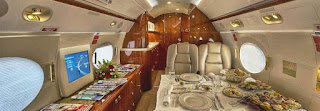http://www.centraljetcharter.com/learjet-85.html
The largest, roomiest and most-capable Learjet yet announced, also has been, arguably, Bombardier’s riskiest business aircraft development program.
Introduced as the Learjet NXT at the 2007 NBAA Convention, Bombardier predicted the breakthrough, all-composite aircraft would be certified and enter service in 2013.
As with many other programs announced by other manufacturers, those milestones never were reached.
And now two years past that promised deadline, the Montreal firm has realigned its aircraft development priorities amid a cash flow crunch.
"The LEARJET 85" next generation in Learjet 85 business jet excellence, the Learjet 85 aircraft is an all-new platform that embodies dramatic advances in aerodynamics, structures, efficiency, and comfort.
"Interior Learjet 85"
learjet 85 interior
True to its Learjet aircraft heritage, it delivers the exceptional performance "Learjet business jet" owners expect from this legendary family of "Jet Aircraft."
Bombardier had a healthy head start on the challenge as its Short Brothers plc subsidiary in Belfast, Northern Ireland, had developed expertise in composite construction using high-temperature, high-pressure autoclaves, among other techniques.
However, rather than capitalize on Shorts know-how in building the entire structure, Bombardier elected to develop a new set of hand layup processes at its facility in Queretaro in north-central Mexico.
Workers had been assembling wiring harnesses and building aluminum structures for other Bombardier models.
And instead of investing in a high-temperature, high-pressure autoclave and resin transfer infusion system at Queretaro, Bombardier elected to use an out-of-autoclave (OOA) construction system that relied on vacuum bagging and low temperature curing of sandwich composite structures.
Eventually, achieving consistent, high-integrity bonding between the sandwich layers would prove problematic. So, Bombardier switched to more monolithic carbon construction for most of the fuselage but retained the hand layup processes.
In contrast, computer-controlled composite layup systems, such as the Fibex filament winding system developed by Rocky Mountain Composites, create tightly wound structures with virtually no air pockets or voids that readily can be cured by using OOA vacuum bagging.
Appearing to be a spider spinning a web, the fully automated Fibex machine’s tool head precisely applies a small quantity of resin and catalyst with the carbon filament and then winds it into a structure. The process creates no lapses, voids or air pockets.
The largest, roomiest and most-capable Learjet yet announced, also has been, arguably, Bombardier’s riskiest business aircraft development program.
Introduced as the Learjet NXT at the 2007 NBAA Convention, Bombardier predicted the breakthrough, all-composite aircraft would be certified and enter service in 2013.
As with many other programs announced by other manufacturers, those milestones never were reached.
And now two years past that promised deadline, the Montreal firm has realigned its aircraft development priorities amid a cash flow crunch.
"The LEARJET 85" next generation in Learjet 85 business jet excellence, the Learjet 85 aircraft is an all-new platform that embodies dramatic advances in aerodynamics, structures, efficiency, and comfort.
"Interior Learjet 85"
learjet 85 interior
True to its Learjet aircraft heritage, it delivers the exceptional performance "Learjet business jet" owners expect from this legendary family of "Jet Aircraft."
Bombardier had a healthy head start on the challenge as its Short Brothers plc subsidiary in Belfast, Northern Ireland, had developed expertise in composite construction using high-temperature, high-pressure autoclaves, among other techniques.
However, rather than capitalize on Shorts know-how in building the entire structure, Bombardier elected to develop a new set of hand layup processes at its facility in Queretaro in north-central Mexico.
Workers had been assembling wiring harnesses and building aluminum structures for other Bombardier models.
And instead of investing in a high-temperature, high-pressure autoclave and resin transfer infusion system at Queretaro, Bombardier elected to use an out-of-autoclave (OOA) construction system that relied on vacuum bagging and low temperature curing of sandwich composite structures.
Eventually, achieving consistent, high-integrity bonding between the sandwich layers would prove problematic. So, Bombardier switched to more monolithic carbon construction for most of the fuselage but retained the hand layup processes.
In contrast, computer-controlled composite layup systems, such as the Fibex filament winding system developed by Rocky Mountain Composites, create tightly wound structures with virtually no air pockets or voids that readily can be cured by using OOA vacuum bagging.
Appearing to be a spider spinning a web, the fully automated Fibex machine’s tool head precisely applies a small quantity of resin and catalyst with the carbon filament and then winds it into a structure. The process creates no lapses, voids or air pockets.




Comments
Post a Comment